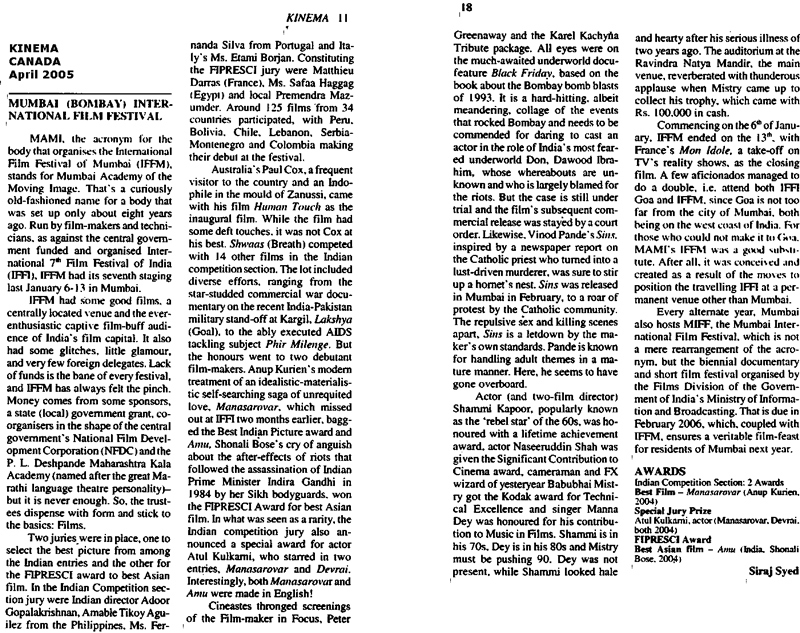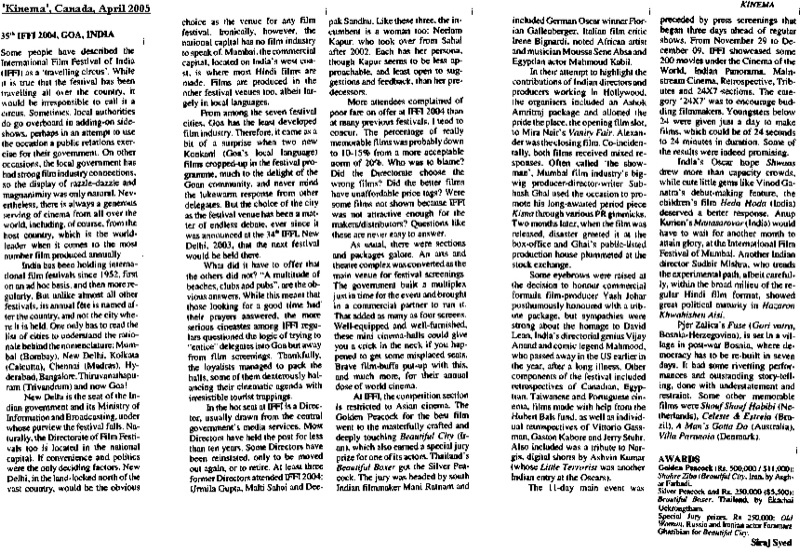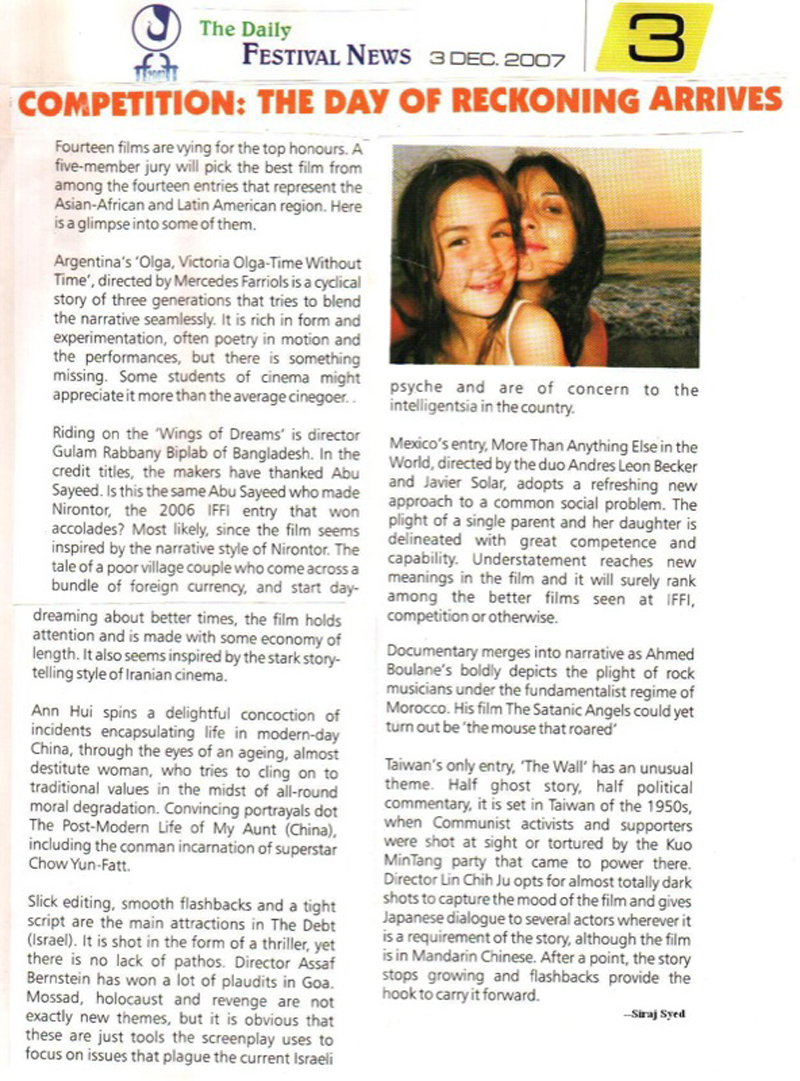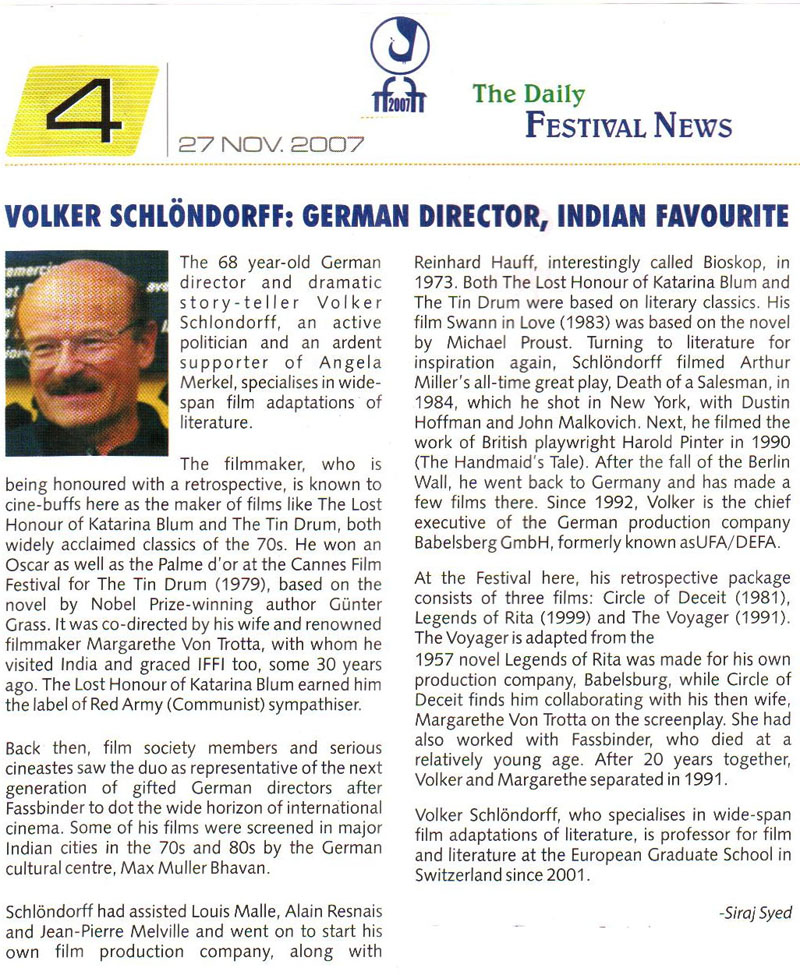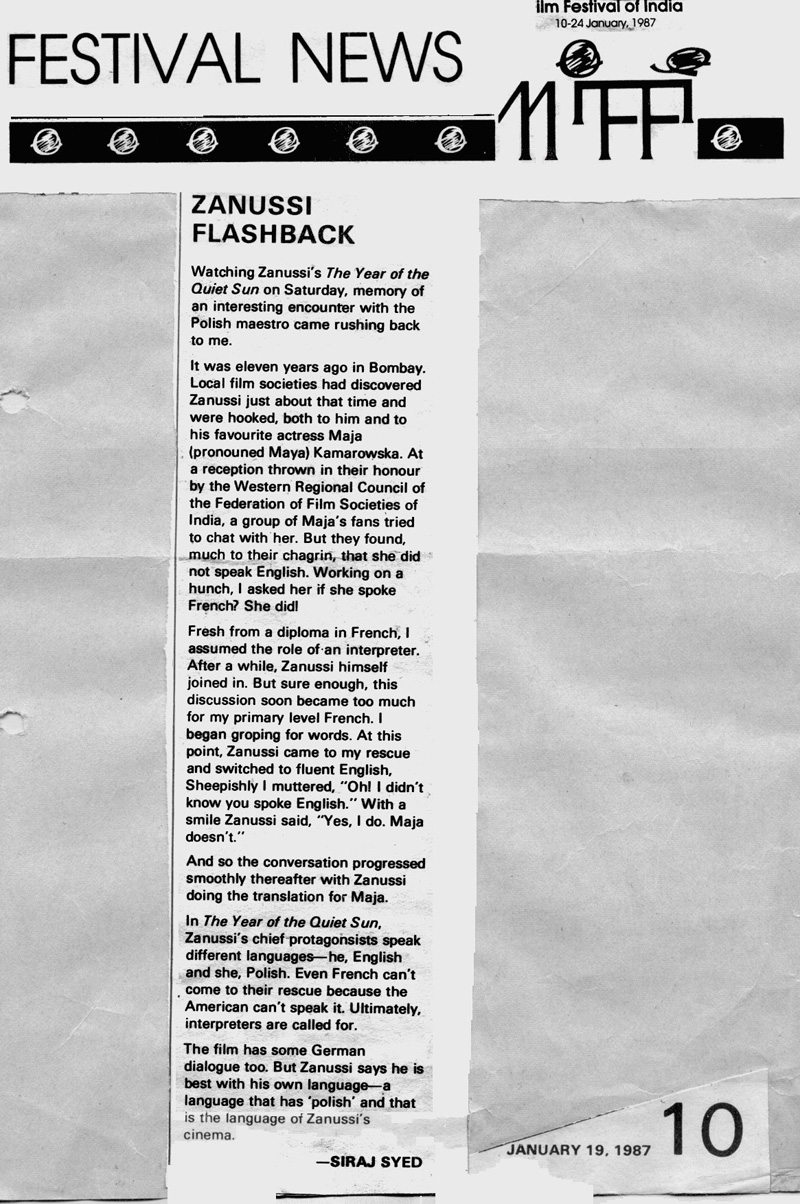|
|
||
|
Pro Tools
FILMFESTIVALS | 24/7 world wide coverageWelcome ! Enjoy the best of both worlds: Film & Festival News, exploring the best of the film festivals community. Launched in 1995, relentlessly connecting films to festivals, documenting and promoting festivals worldwide. Sorry for the interruption, we needed to correct and upgrade some modules. Working on a new website. For collaboration, editorial contributions, or publicity, please send us an email here. You need for put your full detail information if you want to be considered seriously. Thanks for understanding. User login |
Siraj SyedSiraj Syed is the India Correspondent for FilmFestivals.com and a member of FIPRESCI, the International Federation of Film Critics. He is a Film Festival Correspondent since 1976, Film-critic since 1969 and a Feature-writer since 1970. He is also an acting and dialogue coach. @SirajHSyed  An Inconvenient Sequel-Truth to Power, Review by Siraj Syed: Global warning
Former American Vice-President Al Gore says in the film, “In order to address the environmental crisis, we're going to have to spend some time fixing the democracy crisis.” Unless there is a significant democratic will, both in the USA and the rest of the world, a disaster of epic proportions is waiting to happen, is the message, loud and clear. Gore continues his crusade against global warming by making a second film, An Inconvenient Sequel-Truth to Power, to follow up on the Oscar-winning documentary, An Inconvenient Truth (2006).
Firstly, it is not a sequel in any traditional sense. Secondly the calamity is not merely ‘inconvenient’ but earth-shaking. Why he chooses to call both his films euphemistically ‘inconvenient’ eludes me. The only entities for who it might be inconvenient or result in massive losses are the fossil-fuel energy giants!
In June 2017, the film-makers announced that following President Donald Trump's withdrawal from the Paris Agreement, they would re-edit the film to expand Trump’s role as antagonist, while millions of Americans fight back against an administration that prioritises the interests of fossil fuel corporations over the health of our planet. So you have a few shots of Donald Trump speaking on TV and of Gore entering Trump Towers. But for the main part, the film is about Gore’s slide presentations, some stunning footage of global warming induced calamities in the Philippines, India and Miami, and, above all, of the Paris Accord.
Accord de Paris (Paris climate accord or Paris climate agreement), is an agreement within the United Nations Framework Convention on Climate Change (UNFCCC), dealing with greenhouse gas emissions mitigation, adaptation and finance, starting in the year 2020. The language of the agreement was negotiated by representatives of 196 parties at the 21st Conference of the Parties of the UNFCCC in Paris and adopted by consensus on 12 December 2015. As of August 2017, 195 UNFCCC members have signed the agreement, 160 of which have ratified it. The US, after Donald Trump took-over, has withdrawn from it and China has been accused of not being totally sincere. Australia and Russia are said to be vacillating.
In this scenario, immense opportunities exist for India to counter-balance the existing climate leadership equilibrium. Recently, India’s energy minister Piyush Goyal confirmed that the nation would stand committed to its climate goals, laid out in the Paris Agreement, irrespective of “what happens to the rest of the world.” India’s Prime Minister Narendra Modi has his determination to go “above and beyond” the Paris Agreement on climate change. This is indicative of India’s decisive leadership on Climate Change on a global scale.
The Indian cabinet approved the ratification of the Paris agreement on climate change on 2 October, 2016. India has committed itself to reducing the emissions intensity of its gross domestic product by 33-35% by 2030, from 2005 levels, and generate 40% of its cumulative electric power from non-fossil fuel-based energy resources. But this was not before some high drama. As seen in the documentary, Gore met Goyal, prior to Paris, and he expressed the country’s reluctance to move away from coal-powered energy. Goyal’s blunt argument against Gore’s plea was: America used coal for 150 years and polluted the environment, and that Europe and America must take greater initiative. Prime Minister Narendra Modi made a speech about the country’s stand, refusing to sign the accord agreement.
Gore agreed that it was within India’s sovereign rights to refuse, but pointed out that pollution had reached such high levels that we could not see a clear sky any more. He was deeply concerned at the 400 coal-based plants that were coming up in India, and convinced California-based Solar City, America’s No. 1 full solar service provider, to share its intellectual property with India, so that the country can build its own solar panels. He was also responsible for helping to persuade the World Bank to loan $1 billion to implement the new technology. It worked. India agreed. In the context of data that shows Kolkata and Mumbai to be among the cities most endangered by submersion under sea water, a welcome development.
Of course the work that Gore has been doing for all these years is laudable, but one cannot help noticing that the film occasionally tends to highlight its hero personally, not that he does not deserve the glory. One scene, shot at Gore’s 10,000-square-foot house, which is powered entirely by renewable energy, has the former Vice-President talking about the family pictures on his wall. In another, he counters a suggestion that he might want to run for president by saying that he is a “recovering politician”. We even have footage of him congratulating President-elect George W. Bush in the lection that went to the American Supreme Court for the decider. The only bit of humour that I can recall is Gore recalling how a woman in a restaurant felt that he looked and talked like Al Gore, and all he needed to do to complete the resemblance was to dye his hair. After all, the future of the world is no laughing matter.
Often, we can feel the despair that Gore, admittedly, felt himself time and again, along the way. And yet, all does not seem to be lost. Gore was Co-recipient, with the Intergovernmental Panel on Climate Change, of the 2007 Nobel Peace Prize for “informing the world of the dangers posed by climate change... probably the single individual who has done the most to create greater worldwide understanding of the [climate] measures that need to be adopted.” At 69, he does not have too many years to sustain the initiative, and he is well aware of this hard fact. We see him addressing Climate Reality Leaders, a corps he founded, that has a 2,000-plus cadre in over 135 countries. Rashida Atther, who is the only member based in Mumbai, was present at the press preview.
Bay Area based film-makers Bonni Cohen and Jon Shenk, whose credits include Audrie & Daisy, The Island President and The Rape of Europa, have directed the documentary, while Davis Guggenheim, who directed the 2006 release, served as an executive producer on the sequel. The director couple met while studying documentary film-making in Stanford University’s graduate program, and married in 1997. They have collaborated on more than half a dozen films. While shooting, Shenk serves as the director of photography. Cohen tends to work more from her gut, tuning into the subjects on an emotional level.
“Bonni and I are both Jewish, so we both grew up learning about the Holocaust and feel that’s kind of where we are, with the environment, right now. Largely available footage-driven, as is the norm with such projects, Shenk manages to capture some breathtaking visuals of glaciers and snow. Statistics speak for themselves, and are alarming, to say the least. Editing by Don Bernier and Colin Nusbaum is competent. If anything, the problem of climate change is one of epic dimensions, and is now more dangerous than ever. Yet, this time, the footage lasts a full 20 minutes shorter than the first outing, at 98 min.
Overall, something is missing, probably a coherent approach, and the film fails to make the sledge-hammer impact that the issue deserved. Undeniably, it has its heart in the right place, and the warning about global warming needs to be taken very, very seriously by the whole wide world. Sometimes, though, lofty intentions do not translate into great cinema. All the same, An Inconvenient Sequel sure deserves a watch.
“Fight like your world depends on it, because it does” is a Gore quote from the movie.
Don’t go to the theatre to be entertained or captivated, for the scenes you view are not special effects, but natural disasters. And yet, as a concerned citizen and stake-holder in the earth, do make it convenient to see the film.
In the first part, the makers had predicted that even the monument to the 9/11 Ground Zero site could get water-logged. On this count, they earned outrage from many sections of American society. And guess what? It happened. It actually happened. The New York Times reported on November 2, 2012: The main floor of the National September 11 Memorial Museum, still under construction nearly 70 feet below the memorial plaza at the World Trade Center, filled with at least seven feet of water during the storm, its president said Friday. The flooding nearly immersed two fire trucks that have already been placed in the museum and it surrounded the symbolic last column taken from the twin towers.
Power to Truth!
Rating: ***
Trailer:
27.08.2017 | Siraj Syed's blog Cat. : FILM
|
LinksThe Bulletin Board > The Bulletin Board Blog Following News Interview with EFM (Berlin) Director
Interview with IFTA Chairman (AFM)
Interview with Cannes Marche du Film Director
Filmfestivals.com dailies live coverage from > Live from India
Useful links for the indies: > Big files transfer
+ SUBSCRIBE to the weekly Newsletter DealsUser imagesAbout Siraj Syed Syed Siraj Syed Siraj (Siraj Associates) Siraj Syed is a film-critic since 1970 and a Former President of the Freelance Film Journalists' Combine of India.He is the India Correspondent of FilmFestivals.com and a member of FIPRESCI, the international Federation of Film Critics, Munich, GermanySiraj Syed has contributed over 1,015 articles on cinema, international film festivals, conventions, exhibitions, etc., most recently, at IFFI (Goa), MIFF (Mumbai), MFF/MAMI (Mumbai) and CommunicAsia (Singapore). He often edits film festival daily bulletins.He is also an actor and a dubbing artiste. Further, he has been teaching media, acting and dubbing at over 30 institutes in India and Singapore, since 1984.View my profile Send me a message The Editor |


















